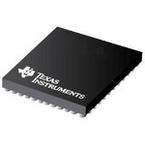Part Datasheet Search > Digital Signal Processors(DSPs) > TI > TMS320C5535AZHHA05 Datasheet PDF
TMS320C5535AZHHA05 Datasheet PDF - TI
| Manufacturer: | TI |
| Category: | Digital Signal Processors(DSPs) |
| Case Package: | 144-LFBGA |
| Description: | DSP Fixed-Point 32Bit 50MHz 50MIPS 144Pin BGA MICROSTAR |
| Documentation: | TMS320C5535AZHHA05 Datasheet (156 Pages)TMS320C5535AZHHA05 User Reference Manual Guide (558 Pages) |
| Pictures: |
TMS320C5535AZHHA05 Datasheet PDF
ADatasheet has not yet included the datasheet for TMS320C5535AZHHA05
If necessary, please send a supplementary document request to the administrator

TMS320C5535AZHHA05 Specifications
| TYPE | DESCRIPTION |
|---|---|
| Mounting Style | Surface Mount |
| Case/Package | 144-LFBGA |
| Number of UARTs | 1 UART |
TMS320C5535AZHHA05 Size & Package
| TYPE | DESCRIPTION |
|---|---|
| Product Lifecycle Status | Active |
| Packaging | Tray |
TMS320C5535AZHHA05 Environmental
TMS320C5535AZHHA05 Function Overview
These devices are members of TI"s C5000 fixed-point Digital Signal Processor (DSP) product family and are designed for low-power applications.
●The fixed-point DSP is based on the TMS320C55x DSP generation CPU processor core. The C55x DSP architecture achieves high performance and low power through increased parallelism and total focus on power savings. The CPU supports an internal bus structure that is composed of one program bus, one 32-bit data read bus and two 16-bit data read buses, two 16-bit data write buses, and additional buses dedicated to peripheral and DMA activity. These buses provide the ability to perform up to four 16-bit data reads and two 16-bit data writes in a single cycle. The device also includes four DMA controllers, each with 4 channels, providing data movement for 16-independent channel contexts without CPU intervention. Each DMA controller can perform one 32-bit data transfer per cycle, in parallel and independent of the CPU activity.
●The C55x CPU provides two multiply-accumulate (MAC) units, each capable of 17-bit x 17-bit multiplication and a 32-bit add in a single cycle. A central 40-bit arithmetic and logic unit (ALU) is supported by an additional 16-bit ALU. Use of the ALUs is under instruction set control, providing the ability to optimize parallel activity and power consumption. These resources are managed in the Address Unit (AU) and Data Unit (DU) of the C55x CPU.
●The C55x CPU supports a variable byte width instruction set for improved code density. The Instruction Unit (IU) performs 32-bit program fetches from internal or external memory and queues instructions for the Program Unit (PU). The PU decodes the instructions, directs tasks to the AU and DU resources, and manages the fully protected pipeline. Predictive branching capability avoids pipeline flushes on execution of conditional instructions.
●The general-purpose input and output functions, along with the 10-bit SAR ADC on the TMS320C5535, provide sufficient pins for status, interrupts, and bit I/O for LCD displays, keyboards, and media interfaces. Serial media is supported through two secure digital (SD) peripherals, four Inter-IC Sound (I2S Bus) modules, one serial port interface (SPI) with up to four chip selects, one I2C multimaster and slave interface, and a universal asynchronous receiver/transmitter (UART) interface.
●Additional peripherals include: a high-speed Universal Serial Bus (USB 2.0) device mode only (not available on TMS320C5532), a real-time clock (RTC), three general-purpose timers with one configurable as a watchdog timer, and an analog phase-locked loop (APLL) clock generator.
●In addition, the TMS320C5535 includes a tightly coupled FFT Hardware Accelerator. The tightly coupled FFT Hardware Accelerator supports 8- to 1024-point (in power of 2) real and complex-valued FFTs.
●Furthermore, the device includes the following three integrated LDOs to power different sections of the device.
●ANA_LDO (all devices) provides 1.3 V to the DSP PLL (VDDA_PLL), SAR, and power-management circuits (VDDA_ANA).
●DSP_LDO (TMS320C5535 and "C5534) provides 1.3 V or 1.05 V to the DSP core (CVDD), selectable on-the-fly by software as long as operating frequency ranges are observed. For lowest power operation, the programmer can shut down the internal DSP_LDO, cutting power to the DSP core (CVDD) while an external supply provides power to the RTC (CVDDRTC and DVDDRTC). The RTC alarm interrupt or the WAKEUP pin can re-enable the internal DSP_LDO and re-apply power to the DSP core. When DSP_LDO comes out of reset, it is enabled to 1.3 V for the bootloader to operate. For the 50-MHz devices, DSP_LDO must be programmed to 1.05 V to match the core voltage, CVDD, for proper operation after reset.
●USB_LDO (TMS320C5535, "C5534, and "C5533) provides 1.3 V to the USB core digital (USB_VDD1P3) and PHY circuits (USB_VDDA1P3).
●These devices are supported by the industry’s award-winning eXpressDSP, Code Composer Studio Integrated Development Environment (IDE), DSP/BIOS, Texas Instruments’ algorithm standard, and the industry’s largest third-party network. Code Composer Studio IDE features code generation tools including a C Compiler and Linker, RTDX, XDS100, XDS510, XDS560 emulation device drivers, and evaluation modules. The devices are also supported by the C55x DSP library which features more than 50 foundational software kernels (FIR filters, IIR filters, FFTs, and various math functions) as well as chip support libraries.
show more
TMS320C5535AZHHA05 Documents
Part Datasheet PDF Search
Example: STM32F103
72,405,303 Parts Datasheet PDF, Update more than 5,000 PDF files ervery day.

